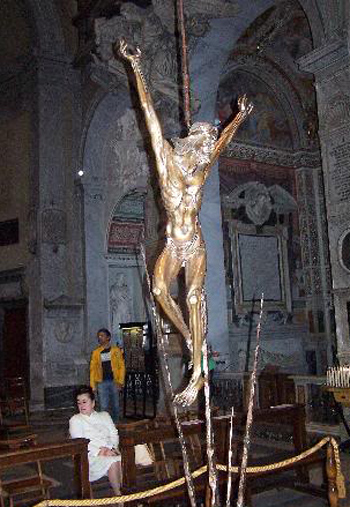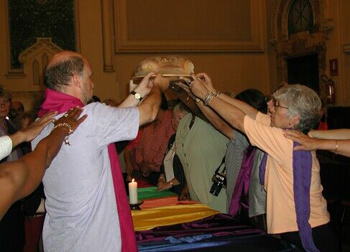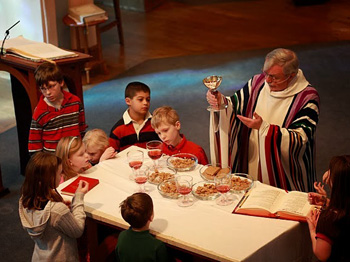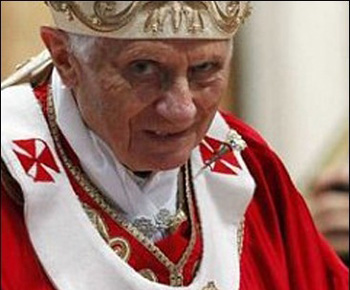Consequences of Vatican II
 |
 |
 |
 |
 |
 |
 |
The Great Moral Flaw in Vatican II - Part I
The Smoke of Satan in the Church
“The darkness of Satan has entered and spread throughout the Catholic Church, even to its summit” - Pope Paul VIThe thesis of this series will seem radical to many and will no doubt be controversial. This series suggests that there was a great moral flaw - not just a moral flaw, but a great moral flaw - in the doings of Vatican II, and that the great moral flaw contains within it an implication that the participants in the Council could not have been cooperating with the oversight of God the Holy Spirit.
The very title of this series might be seen as offensive to those who suggest that there cannot possibly be a “moral flaw” in the Second Vatican Council, or in any Ecumenical Council, because of the oversight of the Holy Spirit. To them, the title may even seem blasphemous.

A distorted grotesque Christ in an empty church - symbolic of the destruction caused by Vatican II
This series, however, suggests that there were indeed moral flaws in the Council. Without quarreling with the thesis that there were many moral flaws both at Vatican II and in the implementation of its documents, it contends that there was indeed one “great” moral flaw - a moral flaw that underlaid and served as a launching point for all the other Vatican II and post-Vatican II moral flaws that have been observed over the past five decades.
Further, this “great” moral flaw is one that, if accepted at face value, threatens the very understanding of this Council as a “legitimate” Ecumenical Council, even casting grave and serious doubt on the proposition that the Holy Spirit was in any way involved in overseeing the doings of the participants in Vatican II.
During the closing ceremonies at the end of the Council, Pope Paul VI joyously informed the world that Vatican Council II had been “assembled in the Holy Spirit and under the protection of the Blessed Virgin Mary … and of Saint Joseph … and of the Apostles Saints Peter and Paul.” (1) Seven years later the same Paul VI, on the otherwise joyous occasion of the ninth anniversary of his election as Pope, issued the following lament:
“We believed that after the [Second Vatican] Council would come a day of sunshine in the history of the Church. But instead there has come a day of clouds and storms, and of darkness ...
“And how did this come about? We will confide to you the thought that may be we ourselves admit in free discussion, that may be unfounded, and that is that there has been a power, an adversary power. Let us call him by his name: the Devil. … It is as if from some mysterious crack, no, it is not mysterious, from some crack the smoke of Satan has entered the Temple of God.” (2)

Mass abuses are routine, causing a loss of belief in the Real Presence among adults and chidlren

- A sharp fall-off in attendance at Mass:
- A strong fall-off in vocations to the priesthood and religious life;
- A cessation of belief in the Real Presence among a clear majority of the laity (some surveys suggest that 70% of Catholics no longer accept it);
- A failure of Catholic schools and teachers to catechize and educate the past two generations of Catholic children in the timeless truths of the Catholic Faith;
- A widespread non-use of the Sacrament of Penance;
- The effects of a relaxed and easier annulment process on understandings of the sanctity and permanence of marriage.
Identifying the crack
What went wrong? What was the “crack” through which the smoke of Satan entered the Church and that caused the hopes and aspirations of the Council’s participants to go unrealized and the Church herself to seemingly go awry - so awry that Paul VI was moved to surmise that the Devil is afoot spreading clouds, storms and darkness within the Church?
One clue as to the identity of the “crack” comes surprisingly from the early, post-Vatican II writings of Pope Emeritus Benedict XVI. Back in 1982, Benedict XVI, then writing as Cardinal Joseph Ratzinger, made some astonishing statements in a treatise on Catholic theology. The statements that he made lie at the heart of a controversy that is currently percolating within the Church, especially in so-called traditionalist and so-called conservative Catholic circles.
First of all, what about the widely held notion that there cannot possibly be a “moral flaw” in Vatican II, or in any Ecumenical Council, because of the oversight of the Holy Spirit. Perhaps surprisingly to some, Card. Ratzinger, in his treatise on Catholic theology, acknowledged the following (and these are his exact words): “Not every valid council in the history of the Church has been a fruitful one; in the last analysis many of them have been just a waste of time.”

Benedict admits a new orientation based on the French Revolution entered the Church at the Council
Have many “valid” Church Councils been “just a waste of time”? Why, if the Holy Spirit watches over the doings of every valid Church Council, would “many” of them turn out to be just a waste of time? Could it possibly be that, in connection with those “many” waste-of-time Councils, the participants failed, for some reason, to cooperate with the Holy Spirit’s oversight?
And is the jury still out, as Card. Ratzinger seems to have suggested, on whether Vatican II itself might be one of those waste-of-time Councils?
Card. Ratzinger came closer to identifying what Paul VI referred to as “a crack through which the smoke of Satan entered the Church” when he went on to suggest that the documents of the Council, and especially its centerpiece, Gaudium et spes (the Pastoral Constitution on the Church in the Modern World), were intended to “correct” what he called the one-sidedness of the anti-modernist position adopted by the Church under Popes Pius IX and St. Pius X. With their Syllabi of errors and Encyclicals these Popes warned against the dangers of that heresy of Modernism. This was a remarkably candid admission.
These were Card. Ratzinger’s words: “If it is desirable to offer a diagnosis of the text [of Gaudium et spes] as a whole, we might say that (in conjunction with the texts on religious liberty and world religions) it is a revision of the Syllabus of Pius IX, a kind of counter-syllabus.” (5)
In a footnote to that quoted passage, Card. Ratzinger explained that “the position taken in the Syllabus [of Pius IX] was adopted and continued in Pius X’s struggle against ‘Modernism.’” (6) Returning to his main text, he went on to write:
“The one-sidedness of the position adopted by the Church under Pius IX and Pius X in response to the situation created by the new phase of history inaugurated by the French Revolution was, to a large extent, corrected via facti, especially in Central Europe, but there was still no basic statement of the relationship that should exist between the Church and the world that had come into existence after 1789 [the year of the French Revolution]. (7)
These considerations by Card. Ratinger lead to the conclusion that a new orientation regarding the modern world was introduced in the Church at Vatican II. Could we say that this “modern” interpretation was the “crack through which the smoke of Satan,” referred to by Paul VI, entered the Church?
The next article should shed more light on this important matter.
Continued
Columbus School of Law
The Catholic University of America
Washington, DC
- Pope Paul VI, In Spiritu Sancto (Apostolic Brief For the Closing of the Council), December 8, 1965.
- Pope Paul VI, Address On the Occasion of the Ninth Anniversary of His Election, June 29, 1972).
- Common usage of the word “pedophilia” often applies the word to the inordinate sexual attraction to and sexual interest in pubescent or post-pubescent minors, but precise usage of the term “pedophilia” confines the term to the inordinate sexual attraction to and sexual interest in pre-pubescent children. “Ephebophilia,” referring to the inordinate sexual attraction to and sexual interest in pubescent or post-pubescent minors.
- Joseph Ratzinger, Principles of Catholic Theology: Building Stones for a Fundamental Theology, (San Francisco: Ignatius Press 1987), p. 378.
- Ibid., p. 381.
- Ibid.
- Ibid., pp. 381-382

Posted March 5, 2014














